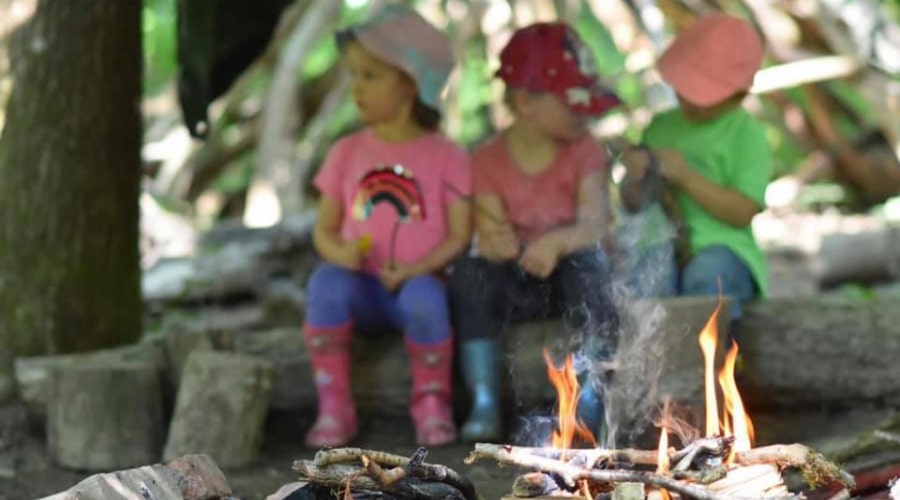Farm and forest school
Horsham
2, 3, 4 year old funded places available
3
settings
240
children
With Famly since
January 2019
What’s stopping you from making changes in your setting?
Lack of staff buy-in? Fear of how parents will react? Perhaps you’re not even sure where to start.
But you’re not alone. Without a huge budget for staff training, or the ability to find more hours in the day, it can seem impossible for some settings to make the improvements they want to in their practice or provision.
Luckily, Little Barn Owls can help.
A small group of farm and forest school settings around Horsham, Sussex, and the UK Nursery Group of the Year 2020, they have plenty of expertise to share. Charlotte, Little Barn Owls’ Group Operations Officer, gives us her top tips for transformation.
The big ideas
- Find your inspiration:
What inspired you to make the changes you want to make? Knowing your ‘why’ will keep you focused and help you create a clear plan. - Open conversations:
Include everyone (children, staff, leadership, and parents) in a conversation about what you’re changing and why. Everyone will understand what’s going on, and can contribute to the discussion. - Set expectations:
Give clear guidance about who is responsible for what. Having ownership over the changes or improvements you’re working on means your team can feel they’re a part of the progress. - Maintain dedication:
Once you’ve decided on your project or change, commit to it. You can, of course, make adjustments and improvements, but keep in mind that things won’t transform overnight. Keep going! - Ongoing evaluation:
Be curious and look for ways to improve every step of the way, always keeping your ‘why’ in mind.
1. Find your inspiration
So you want to make some improvements to your provision…but where on earth do you start? At Little Barn Owls, it’s all about looking to your core philosophies about children and learning.
“We thought, 'This is what we believe about children and what their rights should be', so that’s why we do what we do,” says Charlotte.
If something in your practice and provision doesn’t match your philosophy, that’s what you need to work on. As lovely as they look, the curated classrooms of Instagram only show what's going on on the surface - a new look doesn’t necessarily lead to real change.
There’s a great opportunity to get ideas for development in your regular staff meetings, advises Charlotte. Creating an environment where staff can confidently offer up ideas for changes means you’ll never be short of inspiration for improvement. Not only that, but having an open-door policy for ways to make the setting better means staff feel ownership of solutions, rather than focusing on problems.
So you have your inspiration - what next?
“Once you have a framework of what you’re trying to achieve, that will dictate how you go about it,” says Charlotte. Your plan for change will be unique to your setting, your cohort, and of course, the actual changes you want to make - but once you know what you want to do, the next step is talking it through.

2. Open conversations
Ensuring you communicate how you’re making changes and why you’re making them, means staff, parents, and children can understand the reasoning in what you’re doing. Just explaining the ‘why’ works wonders in driving change and getting everyone on board.
Charlotte and the Little Barn Owls team invited children’s family members into the settings, so the children could learn more about their community, or learn unique skills that those family members had - like gardening! Some parents felt insecure about people they didn’t know interacting with their children. However, rather than pooh-pooh the concerns or end the project, Charlotte and the team explained the ‘why’ to them.
“We had to really involve those parents in the process we’d put in place,” she explains. Once the parents were informed, involved, and assured their children were always supervised, they were much happier.
Charlotte also stresses the importance of giving everyone a forum to share ideas, opinions and concerns openly. Parents who were nervous about the project might not have taken the time to write in, but their Parent-Nursery Association meetings allow for open discussion. Rather than their concerns going unheard, their questions were acknowledged and answered - ultimately strengthening their trust in the setting.

3. Set expectations
Your team can’t do their best to support a change if they don’t know what they’re supposed to be doing to support it.
At Little Barn Owls, Charlotte explains that “Staff understand that they have a part to play in the success of the setting and in each new initiative we take on. The expectations are clear.”
Everyone should be aware of the development plan for the changes you’d like to make in your provision and practice, and specifically, where they fit in.
And it’s not just setting expectations for your staff. Kerry, the Head of Learning and Development, recently created a template so practitioners could improve the quality of their key children’s summative assessments. The leadership team wanted staff to get right to the highlights of the child’s learning and now, the process is more time-efficient and the reports more concise.
“While expectations for staff are high, they must be reflected in expectations of leadership - you can’t just sit behind a desk and tell your team to do something better.” explains Charlotte, “We as leaders want to do everything we can, too.”
4. Maintain dedication
In order to make a change work, it takes commitment from your team, as well as management, and reminding everyone why you’re doing what you’re doing can help keep everyone on track.
Charlotte explains that many initiatives for change can lose steam after the first initial push, and has experience of managers telling her ‘no-ones really doing what I want them to do’. Charlotte’s advice? Always go back to your ‘why’. Demonstrating confidence in your decision, and being able to keep explaining the ‘why’ inspires confidence in children, parents, and staff.
Another way to keep the momentum of a change going is to take small, achievable steps. Your development plan won’t be completed overnight, and there’s no prize for finishing it faster. Knowing your cohort of children and parents will help you decide how much change is manageable at once. A small shift in resources or in your practice is still a move in the right direction and gives everyone a chance to adjust and really embrace and embed the change before moving forward.
To avoid children, parents, and practitioners being overwhelmed with change, Charlotte and the leadership team advocate just keeping what works, as long as it fits with your philosophy. Little Barn Owls is a treasure trove of natural resources, reggio-inspired small parts, glass jars, water-colour paints and, of course, the ateliers - but they have Lego, too.
“You don’t have to make it hard on yourself - you can still have things that help you out,” says Charlotte. “ If that means the children play with Lego, that's fine - as long as it fits with your philosophy and values.”

5. Ongoing evaluation
While maintaining commitment to your change, it’s important to be reflective on what’s working and what could be improved. Charlotte explains that through their experience of opening further Little Barn Owls settings, the leadership team understand the challenges that come with introducing staff and children to something new.
When opening their second setting, Little Barn Owls set out the provision exactly as they had in the first setting.
“We had glass jars everywhere, loose parts-galore, everything open access.” says Charlotte, “...and it was carnage!” she admits. ”The children, who were new to Little Barn Owls, didn't know how to interact with the resources. And the staff, who were also new to us, weren’t used to it either.”
It took experience and time to pare back the provision at the new setting to make it manageable. While not compromising their core values, the team had to evaluate and adapt the provision, then gradually introduce new resources over time.
It’s also key to regularly go right back to the first step of your development plan and revisit your ‘why’. In the busy day-to-day of actually working at your setting, especially in the challenge of making a change, it can be easy to lose sight of what inspired the decision, and go back to what’s easy and familiar.
Charlotte gives the example of how nappies are changed at Little Barn Owls. On a busy day, it would be easier for a practitioner to round up a collection of children, take them to the bathroom, and change their nappies like they were on a conveyor belt - but that doesn’t fit with Little Barn Owls’ philosophy.
“It’s all about the ‘why’. Why do we get down on a child’s level and ask if we can change their nappy? Why take them one at a time when it would be quicker to take a group? Because of what we believe about respecting children and their rights.” says Charlotte, “We always keep going back to that.”
So it’s that easy?
Well, not quite. Improvement takes time, as well as conviction and commitment. These five steps should help you on the way but sadly, there is no shortcut. That being said, improvement is very much more the journey than the destination.
“It’s about the culture you build over time,” says Charlotte, “Eventually you become comfortable with a state of newness, of change, and of thinking about what’s possible and how you can move forward.”
Staff, parents, and children need to understand what’s changing, why, and what their part to play in that is. What’s more, having an idea of how they can contribute to an initiative or project means everyone can feel actively part of what’s happening - and not just that something is happening to them.
Top tips from Alphabet House
Get top tips from a setting just like yours. Hear from Alphabet House on why and how they use Famly - and why they’ve never looked back.
Read their story










